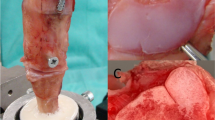Abstract.
We studied the natural lubrication mechanism of synovial joints. We determined the effect of sodium hyaluronate (HA) on lubricating joints without the normal lubrication mechanism. The coefficient of friction (CF) of fresh pig hip joints was measured with the cartilage intact, washed, scoured with gauze and finally with sandpaper, to model cartilage degradation. Three formulas of HA (8×105 daltons 1%, 20×105 daltons 1%, 20×105 daltons 1.5%) and physiologic saline were used as lubricants. We observed the cartilage using light microscopy (LM) and scanning electron microscopy (SEM). The latter showed that the most superficial layer observed in the washed joint was disrupted after gauze scouring. Compared with intact cartilage the CF did not increase with washing. CF increased more after scouring with sandpaper than with gauze. Each formula of HA decreased the CF of joints scoured with gauze, but only the two more viscous HA formulas decreased the CF of sandpaper-scoured joints. A negative correlation was found between the CF of the sandpaper-scoured joints and the logHA viscosity (r=-0.733, P=0.0001), suggesting that HA with higher viscosity was more effective in lubricating the joints.
Résumé.
Nous avons étudié la lubrification naturelle des articulations synoviales. Nous avons déterminé l'effet de l'hyaluronate du sodium (HA) lorsqu'il n'y a pas le mécanisme normal de lubrification . Le coefficient de frottement (CF) de l'articulation fraiche de la hanche de porc a été mesuré avec le cartilage intact, lavé, frotté avec une gaze et finalement altéré avec du papier de verre pour modeliser la déchéance du cartilage. Trois formules de HA (8×105 daltons 1%, 20×105 daltons 1%, 20×105 daltons 1.5%) et du sérum physiologique ont été utilisés comme lubrifiants. Nous avons observé le cartilage en microscopie optique et microscopie électronique. Cette dernière a montré que la couche la plus superficielle observée dans l'articulation lavée a été interrompue après nettoyage à la gaze. Comparé avec cartilage intact, le CF n'a pas augmenté avec le lavage. Le CF a augmenté plus après avoir frotté avec le papier de verre qu'avec la gaze. Chaque formule de HA a diminué le CF des articulations frottées avec la gaze, mais seulement les deux formules HA plus visqueuses ont diminué le CF des articulations altérées avec du papier de verre. Une corrélation négative a été trouvée entre le CF des articulations altérées avec du papier de verre et la viscosité du logHA (r=-0.733, p=0.0001), suggérant que le HA avec viscosité élevée était plus efficace pour lubrifier les articulations.
Similar content being viewed by others
Author information
Authors and Affiliations
Additional information
Electronic Publication
Rights and permissions
About this article
Cite this article
Mori, .S., Naito, .M. & Moriyama, .S. Highly viscous sodium hyaluronate and joint lubrication. International Orthopaedics (SICOT) 26, 116–121 (2002). https://doi.org/10.1007/s00264-002-0330-z
Accepted:
Issue Date:
DOI: https://doi.org/10.1007/s00264-002-0330-z




